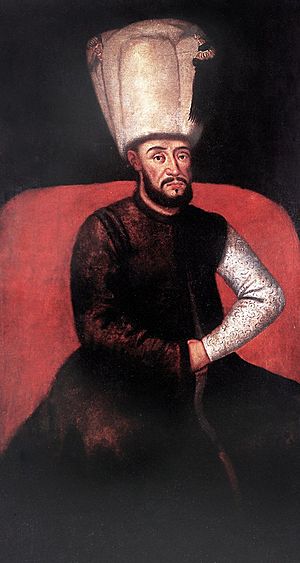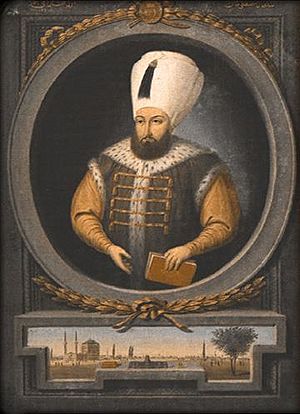Mustafa I facts for kids
Quick facts for kids Mustafa I |
|||||
|---|---|---|---|---|---|
| Kayser-i Rûm Custodian of the Two Holy Mosques Ottoman Caliph Amir al-Mu'minin |
|||||
 |
|||||
| Sultan of the Ottoman Empire (Padishah) | |||||
| 1st reign | 22 November 1617 – 26 February 1618 | ||||
| Predecessor | Ahmed I | ||||
| Successor | Osman II | ||||
| 2nd reign | 20 May 1622 – 10 September 1623 | ||||
| Predecessor | Osman II | ||||
| Successor | Murad IV | ||||
| Born | c. 1600 Topkapi Palace, Constantinople, Ottoman Empire |
||||
| Died | 20 January 1639 (aged 38–39) Eski Saray, Constantinople, Ottoman Empire |
||||
| Burial | Hagia Sophia, Istanbul | ||||
|
|||||
| Dynasty | Osmanoğlu | ||||
| Father | Mehmed III | ||||
| Mother | Halime Sultan | ||||
| Religion | Sunni Islam | ||||
| Tughra | |||||
Mustafa I (born around 1600, died January 20, 1639) was an Ottoman Sultan. He was the son of Sultan Mehmed III and Halime Sultan. People sometimes called him Mustafa the Saint during his second time as ruler. Later, historians called him Mustafa the Mad. He ruled the Ottoman Empire twice: first from November 1617 to February 1618, and then again from May 1622 to September 1623.
Contents
Mustafa I: A Sultan's Story
Early Life and Survival
Mustafa was born around the year 1600 in the Topkapı Palace in Constantinople (now Istanbul). His father was Sultan Mehmed III, and his mother was Halime Sultan.
For a long time, it was a tradition for a new Ottoman Sultan to have his brothers executed. This was done to prevent them from trying to take the throne. Mustafa's own father, Mehmed III, had executed 19 of his brothers!
However, when Mustafa's older half-brother, Ahmed I, became Sultan in 1603, he chose to spare Mustafa's life. This was unusual. One reason might have been the influence of Kösem Sultan, Ahmed's favorite wife. She might have wanted to protect her own sons from Ahmed. If Ahmed's first son, Osman II, became Sultan, he might have executed his half-brothers (Kösem's sons).
Also, at that time, Mustafa was the only other male heir. If Ahmed had executed Mustafa and then died without sons, the royal family line would have ended. So, keeping Mustafa alive was important for the future of the empire. Mustafa lived mostly in the Kafes, a special part of the palace where princes were kept safe but also isolated.
First Time as Sultan
When Sultan Ahmed I died in 1617, it created a new problem for the Ottoman Empire. Several princes could become the next Sultan. A group of important people at the palace decided that Mustafa should be the new Sultan instead of Ahmed's young son, Osman. They thought Osman was too young to rule.
Some officials worried about Mustafa's mental health, but they were outvoted. Mustafa becoming Sultan was a big change. It was the first time an Ottoman Sultan was replaced by his brother instead of his son. This new rule, called "seniority," meant the oldest male in the family would become Sultan.
Mustafa's mother, Halime Sultan, became the Valide Sultan (Queen Mother). She had a lot of power and acted as a regent because of Mustafa's condition. People hoped that being Sultan would help Mustafa's mental health, but his behavior remained unusual. He would sometimes pull off the turbans of his advisors or throw coins to birds and fish.
Why He Was Deposed
Mustafa was often seen as a tool for different groups at the Topkapı Palace. In 1618, after only a short time as Sultan, another group at the palace removed him from power. They put his young nephew, Osman II, on the throne instead. Mustafa was sent back to the Old Palace.
However, a conflict between the Janissaries (elite soldiers) and Osman II gave Mustafa a second chance. After the Janissaries rebelled and killed Osman II in 1622, Mustafa was put back on the throne. He ruled for another year.
Was He Really Unstable?
Some historians believe there isn't enough clear proof that Mustafa was mentally unstable when he first became Sultan. For example, one French ambassador reported that Mustafa was interested in leading a war campaign himself. He even thought about spending the winter in a city called Konya for this purpose.
Some people think that rumors about Mustafa's mental state might have been spread by those who wanted to remove him from power. They might have used these rumors to make their actions seem right.
Second Time as Sultan
When Mustafa started his second reign, he ordered the execution of everyone involved in the murder of Sultan Osman II. Many important officials were executed.
During this time, people sometimes called him "Veli," which means "saint." However, his mental condition did not improve. Mustafa was largely controlled by his mother and his brother-in-law, Kara Davud Pasha, who was the Grand Vizier (a very high-ranking minister).
Mustafa sometimes believed that Osman II was still alive. He would search for him in the palace, knocking on doors and calling out to his nephew to take over the burden of ruling. His mother, Halime Sultan, was truly the one in charge as the Valide Sultan.
Final Years and Legacy
The empire faced a lot of political problems during Mustafa's second reign. There were fights between the Janissaries and another group of soldiers called the sipahis (cavalry). There was also a rebellion led by a governor named Abaza Mehmed Pasha, who wanted to get revenge for Osman II's murder.
To try and stop the rebellion, the government executed Kara Davud Pasha. But Abaza Mehmed continued his advance. Finally, religious leaders and other officials convinced Mustafa's mother to agree to her son being removed from power again. She agreed, but only if Mustafa's life was spared.
So, on September 10, 1623, the 11-year-old Murad IV, another son of Ahmed I, became the new Sultan. Mustafa was sent back to the Kafes, where he lived for the rest of his life. His mother was sent to the Old Palace.
Death
Mustafa died in the Kafes on January 20, 1639. Some sources say he died from epilepsy, possibly made worse by being imprisoned for 34 of his 38 years. He is buried in the courtyard of the Hagia Sophia in Istanbul.
See also
- Transformation of the Ottoman Empire
- In Spanish: Mustafá I para niños


